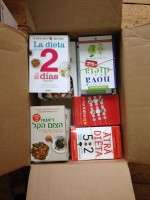I’ve read the Fast Diet book, doing well in my first couple of weeks. I’m a semi-veg (ovo-lacto,occasional piscitarian…) and eat dried beans as a staple protein. I’m puzzled by the bean weight indications in recipes and calorie charts. Cooked beans vary a *lot* in water content and therefore weight. Small weights of dry beans are really impractical to cook. Canned beans are anathema in my household — my husband’s latino, and regards canned beans as inedible (agreed!) So when you give a calorie count for 100 g of lentils, exactly what are you talking about? 100 g cooked, raw, out of a can (drained / undrained)??
NB We have the custom of cooking up a large pot of beans on the weekend. They get boiled daily, which means they decrease in density over the week.
So far, I’ve avoided beans on fast days because of this set of doubts. This constrains my diet more than anything else. I’d feel really freed up if I could get a handle on this question. Thanks.






6:13 pm
31 Aug 13